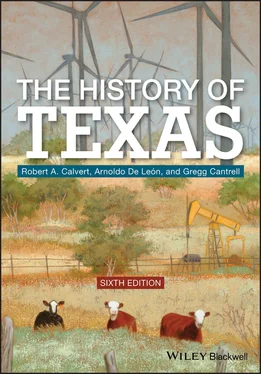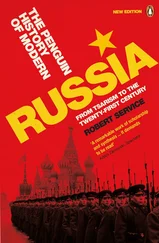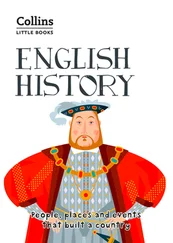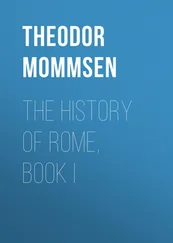During the early 1750s, livestock markets developed in the neighboring provinces of Nuevo León and Coahuila. Before long, Tejano settlers annually journeyed to the fair in Saltillo (in Coahuila), taking with them cattle and horses, suet, and tallow, which they bartered for supplies, implements, and manufactured goods that were scarce in their own settlements.
In the 1770s, Texas ranchers entered into a fairly regular commercial association with markets in Louisiana. When, in 1780, the Spanish Crown issued a concession permitting Tejanos to trade cattle with merchants in Louisiana (which, though acquired by Spain in 1762, was tied to the administrative structure of Cuba), it proved fortuitous for the stockmen. In the next ten years, Tejanos drove countless herds of cattle east. But because this newly legalized trade required a tax on cattle and horses exported from Texas, smuggling continued alongside the extensive legal trade. Furthermore, rancheros established a pattern of marketing animals in the United States, taking their stock from Béxar or Goliad through the Piney Woods of East Texas. Such trade with the outside world strengthened the province’s capitalist orientation, for it encouraged the concentration of private property, contributed to varying degrees of individual wealth, and abetted the division of labor. This interstate commerce eventually forged Texas’s ties to the capitalist economy of the United States.
Although settlers on the frontier planted a number of crops, in Texas, farming did not flourish. Most grantees intending to farm received relatively meager parcels of land, usually as a labor –approximately 177 acres–and too many other factors worked against farming at this time to make it a major means of support. The setbacks included the Tejanos’ reliance on ranching and commerce in livestock; the lack of available workers to undertake the labor‐intensive tasks of clearing land, digging irrigation ditches, and tending crops; the scarcity of farm equipment and the difficulties in transporting it to the frontier; the threat of Indian raids on standing crops; the constant battling of insect infestation; the worry brought on by bad weather conditions; and, perhaps most important, the absence of accessible markets that might have fostered commercial agriculture. Ordinarily, then, farms in colonial Texas were of a hardscrabble, subsistence type that enabled their owners to eke out a living.
In the San Antonio settlements, farmers used the waters of the San Antonio River and San Pedro Creek to irrigate their fields. They raised cotton, pumpkins, melons, corn, beans, and peppers–crops raised by the Béxar mission Indians as well. Whereas some in the East Texas community of Los Adaes undertook farming, early settlers there constantly faced natural disasters, usually in the form of crop‐destroying floods, so that they often called on the nearby French settlements in Louisiana or the Caddos for needed provisions. In Nacogdoches, farmers nurtured small town lots or harvested a variety of vegetable products from nearby fields. La Bahía was located in an infertile area before 1749; and its permanent site in modern Goliad (to which it was moved) did not lend itself to farming–the local garrison was forced to rely on San Antonio for its grain supplies.
As the eighteenth century waned, only four civilian settlements dotted the ranching province. In East Texas, Nacogdoches held 350 settlers as of 1783. South toward La Bahía, approximately 450 pobladores lived in and around the mission and presidio that year ( Figure 2.2). San Antonio, meanwhile, counted 1248 inhabitants. On the Rio Grande, the population of Laredo comprised 700 residents as of 1789. Attempts to establish other civilian units in the early nineteenth century faltered.
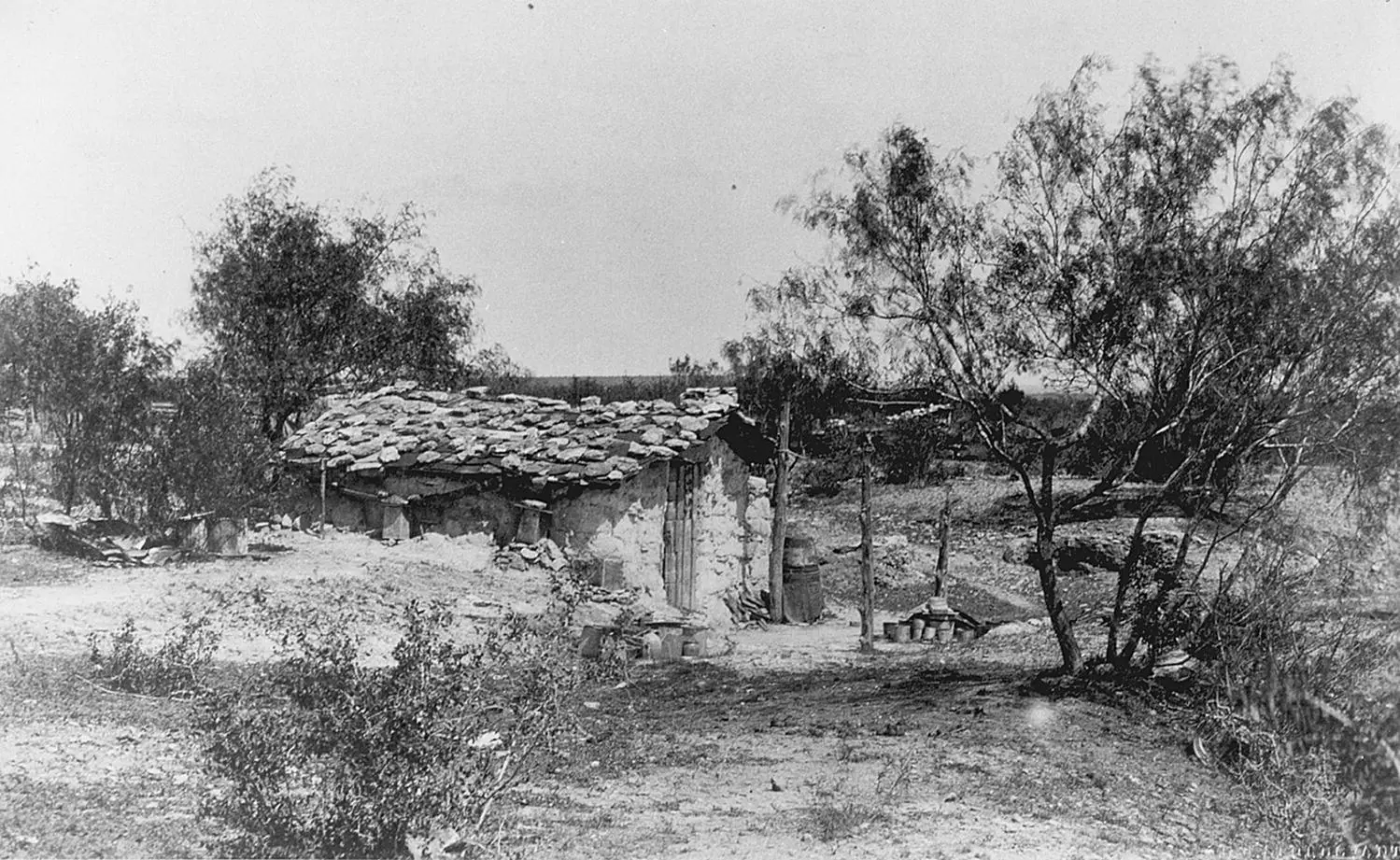
Figure 2.2 The pobladores turned to the environment for materials with which to build homes in the Texas frontera.
Source: Mexicans in San Antonio, Texas , 1887 series E. K Sturdevant, photographer, Daughters of the Republic of Texas Library (SC9995.4.15).
These (relatively) urban sites acted in concert with the other frontier institutions, but they were civilian settlements. Townsfolk included the families of presidial soldiers, Indian neophytes, and even persons on the dodge or those engaged in contraband commerce. Those in charge of town government came from the civilian sector; the alcalde (mayor) cared for the many needs of a municipio (the settlement proper plus outlying areas) through the ayuntamiento . The ayuntamiento further held responsibility for executing imperial directives, building government structures, protecting the urbanites’ property, maintaining law and order, boosting town growth, enforcing morality, and organizing community functions. Like other administrative bodies on the frontier, the ayuntamiento often interpreted royal directives loosely, bending them to meet local and immediate considerations.
Townspeople made a living in a variety of ways. Artisans served presidios and missions, vaqueros did seasonal work on ranches, teamsters transported goods and materials on carts pulled by livestock (horses, mules, donkeys, or oxen), and day laborers performed a range of unspecialized tasks. Merchants, bakers, tailors, shoemakers, blacksmiths, and barbers met the needs of an urban populace. But rancheros also took residence in towns, diversifying and changing the economy. In Béxar, some ranchers used their livestock to produce essential commodities–soap and candles, but also hides, from which leathered body armor and shields were fashioned. In Laredo, rancheros exchanged livestock products and horses for tools and garments brought in from the interior of New Spain. People in other Rio Grande settlements also exported south a wide selection of products native to the area, from fish to mutton to hides. Money remained scarce throughout the province, but urban‐based economic activity, like that on the ranchos, contributed to the nascent Texas economy.
Town living posed numerous problems, but the pobladores managed a crude survival. To make homes, they took advantage of materials readily available in wilderness areas, their domiciles ranging from the undistinguished to the attractive. Masons quarried stone for use in the construction of important buildings. Common people living around San Antonio and southern Texas constructed homes of mud, the type of soil essential for adobe found locally. Mesquite trees, grass, and other natural products were used to build jacales (huts): slender mesquite posts placed in vertical rows served as walls, thatched coverings as roofs. Waterworks to serve a town and its adjacent fields had to be constructed communally. In Béxar, citizens contributed their tools and materials to this end. By their own labor, they built the dams, acequias (irrigation canals), and aqueducts for the town and the neighboring network of missions. As time progressed, even the Canary Islanders, who had once sought to remain aloof from the rest of Béxar society, came to terms with fellow residents; community and family ties impelled them to pull their own weight and deal cooperatively with the adversities of life on the frontier.
Although town living was in some ways safer than life in a rural setting, numerous blights plagued the urbanites. Lack of proper sewage facilities and the concentration of rotting animal waste and carcasses and other litter contributed to the spread of deadly epidemics (such as smallpox and cholera), as did muddy streets (good breeding grounds for mosquitoes during rainy weather). Doctors, drugs, and hospitals rarely made their way to the Far North (the only hospital, which operated for less than ten years, was founded in San Antonio in 1805). Crime committed by vagrants, smugglers, prostitutes, and other social nonconformists became an undeniable aspect of urban life. Finally, attacks by Comanches and other Plains Tribes remained ever possible.
Читать дальше
